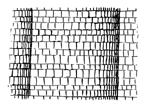
|
|
Methuselah Tree
|

|
|
Classroom Activity
|
Objective
To learn how scientists determine the age of living and non-living
trees.

-
2 copies of the "Tree-Ring Science" student handout (PDF
or
HTML)

-
Tell students they will be taking on the role of a
dendrochronologist, a tree-ring scientist. Provide each student
with two copies of the "Tree-Ring Science" student handout.
-
Students will be crossdating tree-ring samples to determine
which sample is oldest, and will then determine the age of the
oldest sample. This works by comparing the patterns in the
tree-ring samples obtained from trees in the same region that
have experienced similar weather conditions.
-
Have students cut out the samples and study them carefully for
patterns. Make sure students understand how to identify a tree
ring.
-
Have students start with the living tree sample and match any
portion of its rings with one of the other samples. Have them
continue that process until all the samples are used. Then have
them count back from the living sample to the end of the last
sample to determine the age of the oldest specimen in the group.
(See Activity Answer for an example.)
-
The technique in this activity is a simplified representation of
how dendrochronologists date trees. Inform students that the
samples they are looking at represent young trees from the same
area with no abnormalities. Usually, dendrochronologists use
older trees and many more samples to ensure that the crossdating
is correct.
-
As an extension, have students explore other ways that
scientists study core samples to learn about past climates,
including soil cores, ice cores, and coral reef cores.

|

Tree ring
|
The Methuselah Tree has lived more than 4,600 years. The tree rings
on Methuselah and other trees result from the annual growth cycle.
Large cells, made during the spring when rain is abundant, mark the
start of a tree ring. As the seasons continue, growth slows and then
finally stops until the following spring. A continuum of cell growth
size can therefore be seen for each year.
The sizes of each ring depend on many factors, including location,
temperature, soil condition, wind, snow accumulation, sunlight, land
gradient, and tree physiology. In addition, ring growth is not
always annual, so a ring may be absent from a core sample. These are
some reasons why scientists can't rely solely on counting rings and
must use crossdating from multiple samples to ensure accurate age
determination.
The correct tree sample lineage for the activity is:

The age of the oldest tree in the sample is 35.
The bristlecone pine chronology done in the southwest United States
stretches back more than 8,500 years; the European oak and pine
chronology goes back more than 11,000 years.
Besides dating trees and revealing past climate data,
dendrochronology is used to provide information about glacial
activity, volcanic events, and even past insect outbreaks. You may
want to tell students that scientists rarely cut down the trees they
research. Instead, they drill a core sample, about the width of a
pencil, through the tree.

Books
Schweingruber, Fritz H.
Tree Rings: Basics and Applications of Dendrochronology.
Dordrecht, The Netherlands: D. Reidel Publishing Co., 1987.
Covers all topics related to dendrochronology.
Stokes, Marvin A. and Terah L. Smiley.
An Introduction to Tree Ring Dating.
Chicago, IL: The University of Chicago Press, 1968. Republished by
The University of Arizona Press, 1996.
Provides basic dendrochronology information.
Web Sites
NOVA Online—Methuselah Tree
http://www.pbs.org/nova/methuselah/
On this Web site, look at Methuselah and other bristlecone pines
using QuickTime VR, learn how scientists date trees, discover the
nature of longevity, and find out how photosynthesis occurs.
The Ancient Bristlecone Pine
http://www.sonic.net/bristlecone/intro.html
Shows how and where these bristlecone pines were found, and tells
about their unique strategies for survival.
Crossdating Tree Rings Using Skeleton Plotting
http://tree.ltrr.arizona.edu/skeletonplot/introcrossdate.htm
Presents information on how to create skeleton plots.
Majestic Trees of America Timeline
http://www.arborday.org/trees/majTreesTimeline.html
Highlights some tree-related milestones from 2000 b.c., around when
the oldest living tree was born, to 2001 a.d., the year America
voted for a National Tree.
Ultimate Tree-Ring Web Pages
http://web.utk.edu/~grissino/
Provides comprehensive information about dendrochronology and links
to a wide range of dendrochronology resources.

The "Tree-Ring Science" activity aligns with the following National
Science Education Standards:
Grades 5-8

|
Science Standard C:
Life Science
|

|
Structure and function in living systems
-
Cells carry on the many functions needed to sustain life. They
grow and divide, thereby producing more cells. This requires
that they take in nutrients, which they use to provide energy
for the work that cells do and to make the materials that a cell
or an organism needs.
Grades 9-12

|
Science Standard C:
Life Science
|

|
The cell
-
Plant cells contain chloroplasts, the site of photosynthesis.
Plants and many microorganisms use solar energy to combine
molecules of carbon dioxide and water into complex, energy rich
organic compounds and release oxygen to the environment. This
process of photosynthesis provided a vital connection between
the sun and the energy needs of living systems.
|

|






